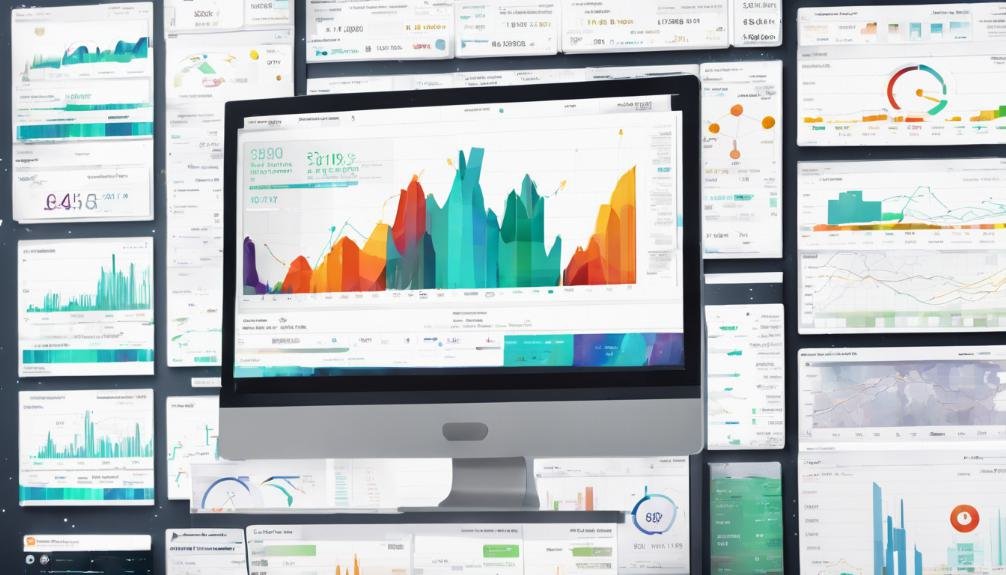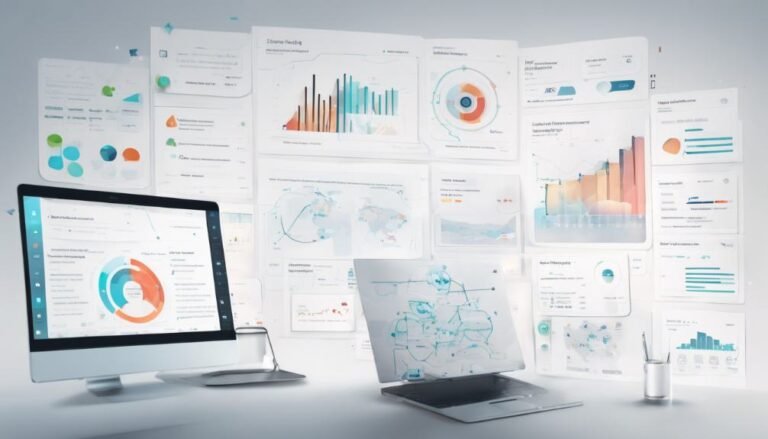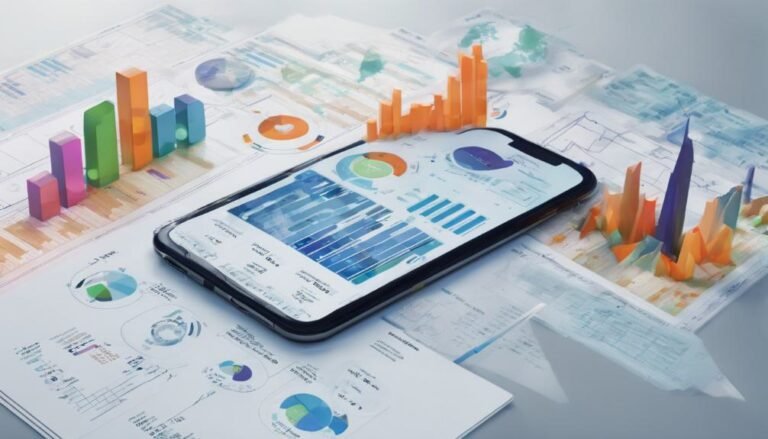AI for Financial Data Visualization
The integration of AI in financial data visualization opens up a world of possibilities for enhancing decision-making processes within the industry. By harnessing the power of artificial intelligence, financial professionals can now access a level of insight and analysis that was previously unattainable. The ability to transform complex data into visually compelling representations not only simplifies comprehension but also streamlines strategic planning and risk management. This synergy between AI and financial data visualization is reshaping the landscape of financial analysis, offering a glimpse into a future where data-driven decisions are not just a possibility, but a necessity for success in an ever-evolving market landscape.
Key Takeaways
- AI enhances financial data visualization with advanced analytics.
- Real-time insights on market trends through dynamic visualizations.
- Interactive dashboards for deep data exploration and collaboration.
- Machine learning algorithms automate analysis for informed decision-making.
- Transform raw data into actionable insights for better financial outcomes.
The Impact of AI in Finance
The integration of artificial intelligence (AI) technologies in the financial sector has greatly transformed operational efficiency and decision-making processes, revolutionizing the way financial data is analyzed and visualized. Through AI, automation benefits such as increased speed, accuracy, and scalability have been realized, allowing for real-time data processing and improved risk management.
However, with these advancements come ethical considerations surrounding the potential biases in AI algorithms and decision-making processes.
Privacy concerns have also emerged as AI systems have access to vast amounts of sensitive financial data. Ensuring regulatory compliance, especially with regulations like GDPR and financial data protection laws, is essential to maintain trust and legality in the financial sector. Companies need to implement robust data protection measures and transparency protocols to address these privacy concerns and abide by regulatory requirements.
Balancing the benefits of AI-driven automation with ethical considerations and regulatory compliance remains a key challenge for the financial industry as it continues to embrace AI technologies for enhanced data analysis and visualization.
Enhancing Data Interpretation
Empowering financial professionals with advanced analytical tools can greatly enhance their ability to interpret complex data sets effectively. Data analysis plays an essential role in understanding market trends, identifying risks, and making informed investment decisions.
By leveraging AI-driven algorithms, financial data visualization tools can transform raw data into visually appealing and interactive dashboards that facilitate quick and accurate interpretation.
Visual storytelling within financial data visualization enables professionals to communicate insights in a compelling and easy-to-understand manner. Visualization techniques such as charts, graphs, and heat maps help in identifying patterns, outliers, and correlations that may not be apparent through raw data analysis alone.
This storytelling approach not only simplifies complex financial information but also enhances decision-making processes by presenting data in a visually digestible format.
Incorporating AI into data interpretation processes allows for real-time analysis, predictive modeling, and scenario planning, enabling financial professionals to stay ahead of market fluctuations and make proactive decisions.
Real-time Visualization Solutions
Utilizing cutting-edge technology, real-time visualization solutions offer financial professionals immediate access to dynamic data insights for swift decision-making in the fast-paced world of finance. These solutions leverage dynamic graphics to represent streaming data in a visually engaging manner, enabling users to quickly grasp trends, patterns, and anomalies within financial datasets.
By providing real-time updates and interactive visualizations, financial professionals can monitor market fluctuations, track portfolio performance, and identify opportunities or risks as they emerge.
The use of dynamic graphics enhances the interpretation of streaming data by presenting information in a clear, concise, and actionable format. This real-time visualization capability allows for on-the-fly analysis, enabling users to make informed decisions promptly.
Additionally, the interactive nature of these visualizations empowers users to explore deeper into the data, drill down into specific metrics, and gain a thorough understanding of the underlying factors driving financial trends. Essentially, real-time visualization solutions are invaluable tools for enhancing decision-making processes in today's rapidly evolving financial landscape.
Predictive Analytics Applications
Predictive analytics applications in financial data visualization play a pivotal role in forecasting future trends. They enable organizations to anticipate market movements and make informed strategic decisions. These applications also enhance risk assessment accuracy by analyzing historical data patterns and identifying potential vulnerabilities in real-time.
Ultimately, they provide decision-making support by offering valuable insights that empower businesses to react promptly to market changes and opportunities.
Forecasting Future Trends
Analysis of historical financial data enables the identification of patterns and trends that can be leveraged to anticipate future market movements and make informed decisions. Through trend analysis and pattern recognition, financial experts can utilize predictive modeling techniques to forecast future trends accurately.
By employing advanced data visualization tools, such as interactive charts and graphs, these predictions can be communicated effectively to stakeholders. Predictive analytics applications allow financial professionals to not only understand past trends but also to anticipate potential market shifts and make proactive decisions.
Essential modeling plays a vital role in forecasting future trends by analyzing historical data to identify patterns that indicate potential market directions. By visualizing this data through intuitive dashboards and reports, financial analysts can gain valuable insights into future market behavior.
Leveraging predictive analytics tools enables businesses to stay ahead of the curve, anticipate changes, and adjust strategies accordingly. As technology continues to advance, the accuracy and efficiency of essential modeling in forecasting financial trends are expected to further improve.
Risk Assessment Accuracy
Enhancing the precision of risk assessment in financial decision-making can be achieved through the strategic application of advanced predictive analytics tools. By focusing on risk prediction and data accuracy, financial institutions can better understand and mitigate potential risks.
To improve risk assessment accuracy, the following key strategies can be implemented:
- Utilizing Robust Modeling Techniques: Employing sophisticated modeling approaches such as machine learning algorithms can enhance the accuracy of risk assessments by identifying complex patterns in financial data.
- Validating Data Accuracy: Validating the quality and reliability of the data used for risk assessment is vital to guarantee the effectiveness of predictive analytics models.
- Algorithm Validation: Thoroughly validating the algorithms used for risk prediction is essential to evaluate their performance and reliability in different scenarios.
- Regular Monitoring and Updating: Continuously monitoring and updating predictive models can help ensure that they remain effective in accurately evaluating risks in dynamic financial environments.
Decision-Making Support
In the domain of financial data visualization, utilizing advanced analytics tools can greatly enhance decision-making processes by offering valuable insights and support. Cognitive assistance plays a key role in providing strategic planning recommendations based on data analysis.
By leveraging predictive analytics applications, businesses can access algorithmic guidance that aids in making informed investment decisions. These tools enable professionals to sift through vast amounts of data efficiently, identifying trends, patterns, and potential risks that may impact strategic choices.
Strategic planning benefits from the integration of predictive analytics, allowing decision-makers to anticipate market movements and adapt their approaches accordingly. Algorithmic guidance assists in optimizing investment decisions by providing data-driven recommendations that align with organizational goals and risk tolerance levels.
This proactive approach to decision-making support can lead to more informed and successful outcomes in the dynamic landscape of financial markets. By harnessing the power of predictive analytics, businesses can stay ahead of the curve and make strategic decisions with confidence.
Interactive Dashboards for Insights
Utilizing interactive dashboards is pivotal in extracting valuable insights from financial data, allowing for dynamic visualization and analysis. Interactive dashboards enhance user engagement by providing a hands-on approach to exploring data, fostering a deeper understanding of complex financial information. They facilitate visual storytelling, enabling users to communicate findings effectively through compelling visualizations.
- Customization Options: Interactive dashboards offer customization features that allow users to tailor visualizations to their specific needs, ensuring relevance and clarity in the presentation of financial data.
- Data Exploration: Users can dive deep into the data, uncovering trends, patterns, and anomalies through interactive elements like filters, drill-downs, and tooltips.
- Real-time Updates: Dashboards can be designed to pull real-time data, providing users with up-to-date information for timely decision-making.
- Collaboration Capabilities: Interactive dashboards often support collaboration features, enabling teams to work together on analyzing and interpreting financial data, fostering a collaborative environment for insights generation.
Leveraging Machine Learning Algorithms
Utilizing the power of machine learning algorithms is essential for harnessing the full potential of financial data visualization in modern analytics. Image recognition plays a significant role in transforming raw financial data into visually digestible insights.
By leveraging machine learning models, financial analysts can automate the process of data analysis, enabling them to identify trends, correlations, and outliers more efficiently.
Moreover, anomaly detection using machine learning algorithms enhances the ability to pinpoint irregularities in financial datasets, such as fraudulent transactions or unusual market behavior. These algorithms can sift through vast amounts of data to detect patterns that may not be apparent through traditional analysis methods.
Pattern recognition algorithms within machine learning frameworks help financial institutions forecast market trends, customer behavior, and investment opportunities. By analyzing historical data and identifying recurring patterns, these algorithms empower decision-makers to make informed choices based on data-driven insights.
Conclusion
To sum up, the integration of AI in financial data visualization has greatly transformed the way professionals analyze complex data. Through advanced algorithms and machine learning, real-time insights, predictive analytics, and interactive dashboards have become readily accessible.
This revolution in data interpretation allows stakeholders to navigate vast amounts of financial information with precision and clarity. As financial professionals embrace AI technologies, the future of data visualization in finance holds promising opportunities for informed decision-making.







